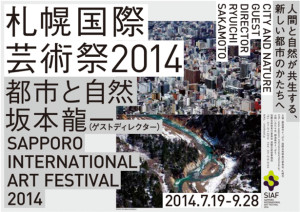Sapporo International Art Festival 2014
July 19–September 28, 2014
Theme: City and Nature
Sub-themes: Nature / City / Economy, Community and Life
Guest director: Ryuichi Sakamoto
Main venues:
Hokkaido Museum of Modern Art
Sapporo Art Museum
Sapporo Ekimae-dori Underground Walkway (a.k.a. Chi-Ka-Ho)
Moerenuma Park and more
Artists:
A.P.I, Subodh Gupta, Naoya Hatakeyama, Byeong Sam Jeon, Anselm Kiefer, Tetsumi Kudo, Takashi Kuribayashi, Daito Manabe, Taiji Matsue, Soichiro Mihara, Aiko Miyanaga, Fujiko Nakaya, Carsten Nicolai, Shinro Ohtake, Masao Okabe, Jungsun Park, Tomás Saraceno, Shiro Takatani, Fuyuki Yamakawa and more.
The contemporary art exhibition which is scheduled to be held at Hokkaido Museum of Modern Art and Sapporo Art Museum will be the core element of the Sapporo International Art Festival 2014. It will showcase works by Japanese and international artists featuring the history of modernization in Hokkaido and Japan as well as their natural environments. The ultimate aim is to allow reassessment for the future of the natural environment of Sapporo and Hokkaido and to promote consideration of the characteristics of ideal urban areas, energy consumption and daily lifestyles.
“Chi-Ka-Ho” is a 520-meter underground walkway featuring exhibition spaces, and provides a direct connection between Sapporo Station and Odori Subway Station. By utilizing this space, another area of the core exhibition Sensing Streams will be held focusing on the information technology that permeates society/urban environments and connects people. This project will involve multiple artists sensing various information streams in society and cities as a basis for dynamic visualization and sonification.
Other highlights include various regional programs featuring the natural environment of Hokkaido. The location for these programs will be at historical edifices around Sapporo and Moerenuma Park designed by Isamu Noguchi.
Message from Guest Director Ryuichi Sakamoto
The land that was named Hokkaido after the Meiji Restoration can be seen as a symbol of Japan’s modernization due to the part it played. Even the indigenous people and nature of Hokkaido were not immune from that modernization. By looking back on our past through art we can explore the concept of nature, cities, economy and lifestyles in Sapporo/Hokkaido in the 21st century (The concept of social sculpture). Leading-edge work based on the themes will be displayed in the most suitable places.


